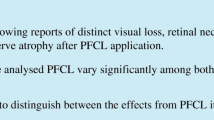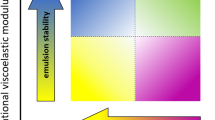Abstract
Purpose
To compare the analytical quality characteristics of currently available CE-marked silicone oils used as ocular endotamponades in vitreoretinal surgery.
Methods
Thirty-four samples of 12 brands were analysed. To assess the quality characteristics of silicone oils, we measured the oligosiloxane content and polydispersity, widely accepted as purity parameters. UV-active substances (> 220 nm) were analysed to draw conclusions about the integrity of primary packaging components.
Results
We identified significant differences in the impurity profiles of the products tested, which revealed oligosiloxane contents ranging from < 0.1 to 491 ppm, polydispersity ranging from 1.6 to 3.0 and UV-active substances (> 220 nm) ranging from 0.2 to 3.8 AU.
Conclusion
The quality characteristics of the analysed silicone oils vary significantly not only among different brands but also among batches of the same manufacturer. Manufacturers should communicate the purity and quality characteristics of their products in an understandable and clear manner. This involves providing a complete certificate of analysis with special focus on quality characteristics, to enable the vitreoretinal surgeon to differentiate between the effects of the silicone oil itself and those of impurities.
Similar content being viewed by others
Change history
05 August 2020
The orignal publication of this paper contains error in the PDF version of Table 2 for the “Median” was missing. Please see below corrected Table 2.
References
Cibis PA, Becker B, Okun E et al (1962) The use of liquid silicone in retinal detachment surgery. Arch Ophthalmol 68:590–599
Scott JD (1975) The treatment of massive vitreous retraction by the separation of pre-retinal membranes using liquid silicone. Mod Probl Ophthalmol 15:285–290
Zivojnovic R, Mertens DAE, Peperkamp E (1982) Das flüssige Silikon in der Amotiochirurgie (II). Bericht über 280 Fälle. Weitere Entwicklung der Technik. Klin Monatsbl Augenheilkd 181:444–452
Stilma JS, Koster R, Zivojnovic R (1986) Radical vitrectomy and silicone oil injection in the treatment of proliferative vitreoretinopathy following retinal detachment. Doc Ophthalmol 64:109–116
Eckardt C, Nicolai U, Czank M et al (1992) Identification of silicone oil in the retina after intravitreal injection. Retina 12(3 suppl):17–22
Eckardt C, Nicolai U, Czank M et al (1993) Okulare Gewebe nach intravitrealer Silikonölinjektion. Ophthalmologe 90:250–257
Ni C, Wang WJ, Albert DM et al (1983) Intravitreous silicone injection. Histopathologic findings in a human eye after 12 years. Arch Ophthalmol 101:1399–1401
Mendichi R, Schieroni AG, Piovani D, Allegrini D, Ferrara M, Romano MR (2019) Comparative study of chemical composition, molecular and rheological properties of silicone oil medical devices. Trans Vis Sci Tech 8(5):9. https://doi.org/10.1167/tvst.8.5.9
Rubber closures for containers for aqueous parenteral preparations, for powders and for freeze-dried powders. Ph.Eur. 10.0 (2018), 3.2.9: 460–462
Lucke K, Laqua H (1990) Silicone oil in the treatment of complicated retinal detachments. Springer, Berlin, Heidelberg
Hammer M, Margo CE, Grizzard WS (1997) Complex retinal detachment treated with silicone oil or sulfur hexafluoride gas: a randomized clinical trial. Ophthalmic Surg Lasers 28(11):926–931
Nakamura K, Refojo MF, Crabtree DV (1990) Factors contributing to the emulsification of intraocular silicone and fluorosilicone oils. Invest Ophthalmol Vis Sci 31(4):647–656
Acknowledgements
I would like to thank the analytical department of Pharmpur GmbH for the GMP-compliant performance of the silicone oil analyses.
Identification code
B Alchimia
C Arcadophta
D Bausch&Lomb
E Biotech
F DORC
G FCI
H Fluoron
K Meran
L Miray Medikal
M Oculentis
N Teknomek
O Pharmpur
Glossary
AU: Arbitrary unit
Best case: Sample with the best value in this analytical category
Educt: Substance separated from a mixture in which it already existed, as opposed to a product, which is newly generated by a chemical reaction
Headspace: Gaseous constituents of a closed space above liquids or solid emitting and vapours measured using headspace gas chromatography
Linearity: Linearity is the property of a mathematical relationship or function which means that it can be graphically represented as a straight line.
Number average molecular weight: Average of the molecular masses of the individual macromolecules.
Oligosiloxanes: Polysiloxane having a relatively small number of –Si–O– groups
Polydispersity: Measure for the broadness of a molecular weight distribution of a polymer.
Siloxanes: Functional group in organosilicon chemistry with the Si–O–Si linkage
Weight average molecular weight: Total weight of polymer divided by the total number of molecules.
Author information
Authors and Affiliations
Ethics declarations
Conflict of interest
Author is Chairman of Working Committee NA 027-01-20 of German Institute for Standardization (DIN) and Leader of project ISO 16672, Ophthalmic implants—Ocular endotamponades in the International Standardization Organization (ISO).
In the past, the author has been consulting for a variety of ophthalmic companies (Bausch and Lomb, Chauvin, Cromapharma, DORC, HumanOptics, Hyaltech, i.com medical, MIRO, Pharmpur, Second Sight, THEA, Technolas Perfect Vision, Valeant) in regulatory affairs, quality management, research and development.
Ethical approval
This article does not contain any studies with human participants or animals performed by any of the authors.
Additional information
Publisher’s note
Springer Nature remains neutral with regard to jurisdictional claims in published maps and institutional affiliations.
Rights and permissions
About this article
Cite this article
Dresp, J.H. Benchmarking different brands of silicone oils. Graefes Arch Clin Exp Ophthalmol 259, 13–20 (2021). https://doi.org/10.1007/s00417-020-04809-2
Received:
Revised:
Accepted:
Published:
Issue Date:
DOI: https://doi.org/10.1007/s00417-020-04809-2




